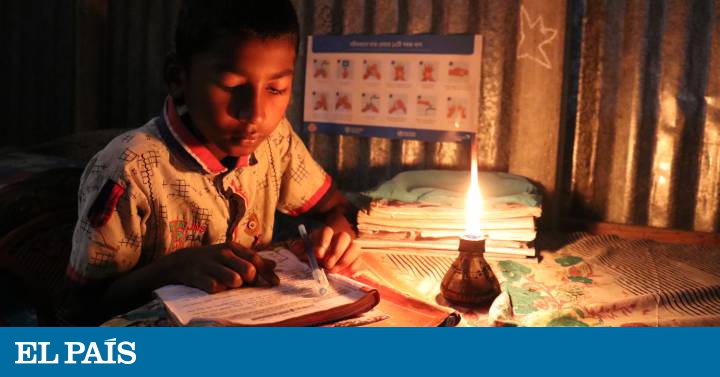MORE INFORMATION
The pandemic through the eyes of adolescent girls (II): losing school is losing your life
Almost 20 million more people suffer acute hunger after the pandemic
Child abuse, the silent threat of quarantine in Argentina
Since the outbreak of Covid-19, the world's children and adolescents have been described as the "hidden, invisible" victims of this health crisis. Although the SARS-CoV-2 virus has been, to date, a disease with a low incidence of infected and mortality among the youngest, there are already many collateral effects that have begun to show the consequences that children will suffer. In the last month, some voices and several reports warn that child malnutrition, lack of income, mental health illnesses and inequalities in education and gender are fundamental challenges that must be faced in order not to doom future generations.
Education for all, without digital divide
At the beginning of March, the world closed its schools and around one billion students and young people around the world were affected by the covid-19 outbreak, according to UNESCO figures.
Already in August, the UN warned of the "generational catastrophe" that would mean not immediately reopening schools.
Today, six months later, at least 53 countries remain with their schools closed, and many others have ended their academic year.
"Even before the pandemic, millions of children and young people were missing out on quality education and training opportunities because they did not have access to the Internet. Now, covid-19 has made the situation worse," said UNICEF executive director Henrietta Fore , in a talk at the beginning of September organized by
Generation Unlimited,
in which leaders from all over the world participated, under the auspices of the United Nations.
"We have a unique opportunity to bridge the digital divide and make Internet access a reality for all children and young people, and in all schools and communities," Fore added.
A recent UNICEF report highlighted that at least one in three schoolchildren worldwide was unable to access distance learning after school closings, highlighting the lack of access to digital technology.
If you look at Africa, Unicef estimates that at least half of the school-age children in the sub-Saharan region do not have access to the Internet.
"Investing resources in the digital learning and training of young people is essential to build social cohesion and reduce the unsustainable inequalities that block human development and economic growth," said the Secretary General of the United Nations, António Guterres, in the same event in which, in addition, organizations committed to reaching 3.5 billion children and young people with quality education, including digital solutions, by 2030.
Plans for the reopening of schools should include protection measures and psychosocial support to ensure that girls learn in a safe environment.
✔ Discover the Guide for the return of girls to school:
👉🏼 https://t.co/Cl3pBxddh2 # LaEducaciónContinúa pic.twitter.com/craMcbAjfV
- UNESCO in Spanish (@UNESCO_es) September 18, 2020
But digital is not the only gap that covid-19 has uncovered in the educational world.
The other important barrier that concerns organizations is that of gender.
Unesco fears that around 10 million girls of secondary school age may not go back to school after the pandemic, leading to an increase in child marriages and labor exploitation, among other consequences.
Covid-19 is a thrust lever for infant mortality
David del Campo, Director of Humanitarian Action and International Cooperation at Save The Children
"Girls from lower socioeconomic levels are at higher risk of not going back to school. In these families, many of which subsisted in the informal economy, incomes have been reduced or completely disappeared, so they cannot afford the costs of education. education or leave their daughters in charge of the house and family, doing housework while the others go to work. This would mean a setback of some 20 years in the progress towards gender equality ", explains Julia López, director of communication and political incidence of Plan International in Spain.
The NGO has launched the #GirlsInCrisis campaign with which it plans to benefit 20 million people, especially girls and adolescents, from 52 countries and thus guarantee access to education in a safe and inclusive way, the protection of children against violence and promoting the employment of young women.
In early September, Reinforcing Equality: A Guide to Returning Girls to School was also launched, an initiative of Fonds Malala, Plan International, UNESCO, Ungei and Unicef, to help those in charge of the Ministries of Education to address the gender dimensions of covid-19-related school closures.
In it there is information that emphasizes an approach based on “reinforcing equality”, through measures with a gender perspective that transform education systems, prioritize resilience, and address the main obstacles and limitations for girls' education. as explained by the partners of the Gender Reference Group of the World Coalition for Education covid-19 of UNESCO.
Food insecurity and child malnutrition
Ubah, 33, poses with four of her six children in the Puntland refugee camp, Somalia.
Said M. Isse Save the Children
Almost 20 million more people suffer from acute hunger in the world, as announced last week by the Global Network Against Food Crises at the annual UN Assembly.
And children and young people are being one of the groups most affected.
"Covid-19 is a lever for child mortality," says David del Campo, director of humanitarian action and international cooperation at Save The Children.
The humanitarian organization has warned that 67,000 children are at risk of dying of hunger in sub-Saharan Africa before the end of the year due to the serious impact of the Covid-19 crisis.
These figures, which come from a new analysis that the NGO has carried out with data published in
The Lancet
, reveal that approximately 426 children can die every day if urgent measures are not taken.
Save The Children recalls that in the first quarter of 2020 different studies estimated that covid-19 would increase poverty in sub-Saharan Africa by 23% and warns that the most recent reports already indicate that by 2030 there may be 433 million people suffering from malnutrition In the continent.
“Life was hard for me and my family, but I worked hard and we survived.
The coronavirus has made the situation worse because there is little work and too much space.
We only ate once a day, in the morning.
I have seen my children go to sleep hungry.
The worst feeling for a mother is seeing that she cannot feed her children, ”explains Ubah, a mother of six in Puntland (Somalia) to Save The Children, which provides her with food assistance.
Before the pandemic, sub-Saharan Africa was one of the world's most food-insecure regions and fears that if current trends continue, it will be home to more than half of the world's chronically hungry people.
“Every day more children come to our clinics with symptoms of malnutrition and this is only the beginning.
If we wait until the clinics are full, it will be too late.
The food crisis could kill tens of thousands of children if they do not receive immediate humanitarian assistance, ”explains Ian Vale, Save The Children's Regional Director for Eastern and Southern Africa.
Nine out of ten girls worldwide confess to having a high or medium level of anxiety as a result of the pandemic
Another consequence that directly affects children and that has been exacerbated by the pandemic is child malnutrition.
In Brazil, the third most infected country in the world, 49% of Brazilians have reported changes in eating habits, with a considerable increase in the consumption of junk food, since the pandemic began.
Among families living with children and adolescents, the impact was even greater: 58% said they had changed their diet, according to data from research carried out by Unicef entitled
Primary and secondary impacts of COVID-19 on children and adolescents
.
"We are facing a worrisome scenario of malnutrition. On the one hand, we have seen an increase in the consumption of unhealthy foods, which contributes significantly to the increase in overweight and chronic non-communicable diseases. On the other, we see the increase in food and nutritional insecurity that can lead to malnutrition and micronutrient deficiencies. This situation mainly affects the most vulnerable populations and has long-term effects. It is essential to act immediately to reverse this scenario, "says Cristina Albuquerque, health chief of Unicef in Brazil.
Anxiety and uncertainty about the future
Child abuse during quarantine, depression, abuse and the stress of confinement, as well as uncertainty about the future, are some of the great concerns in relation to the little ones.
Nine out of ten girls worldwide confess to having a high or medium level of anxiety as a result of the pandemic, according to the new study by the NGO Plan International,
Lives interrupted: the impact of COVID-19 on girls and young women .
The most frequent fears among those surveyed, which includes the experiences of more than 7,000 adolescents between 15 and 19 years of age from 14 countries, are the well-being of their families, which worries 40%, as well as their own health, an issue that worries to 33%.
The research, which has been carried out in the United States, Brazil, Ecuador, Nicaragua, Spain, France, India, Australia, Vietnam, Zambia, Ethiopia, Ghana, Egypt and Mozambique, shows that there is a correlation between the degree of anxiety and their socioeconomic status: the lower it is, the higher the stress levels of young women.
“This study serves as a wake-up call for governments to include a gender and age approach in their responses to the pandemic.
For girls and adolescents, especially the most vulnerable, this crisis has led to an increase in inequality and the risks they faced, ”explains Concha López, General Director of Plan International.
The report highlights the challenges and concerns that girls and adolescents are having due to the pandemic in the different areas of their lives, from their education to their ability to become independent and socialize (*).
All of them, alarms to take into account for the future of the new generations.
(*) From the hand of Unicef we are offering in recent weeks several documentary videos on the subject:
- The pandemic through the eyes of adolescent girls (I)
- The pandemic through the eyes of adolescent girls (II): losing school is losing your life
You can follow PLANETA FUTURO on Twitter and Facebook and Instagram, and subscribe to our
newsletter
here
.










/cloudfront-eu-central-1.images.arcpublishing.com/prisa/KMEYMJKESBAZBE4MRBAM4TGHIQ.jpg)


